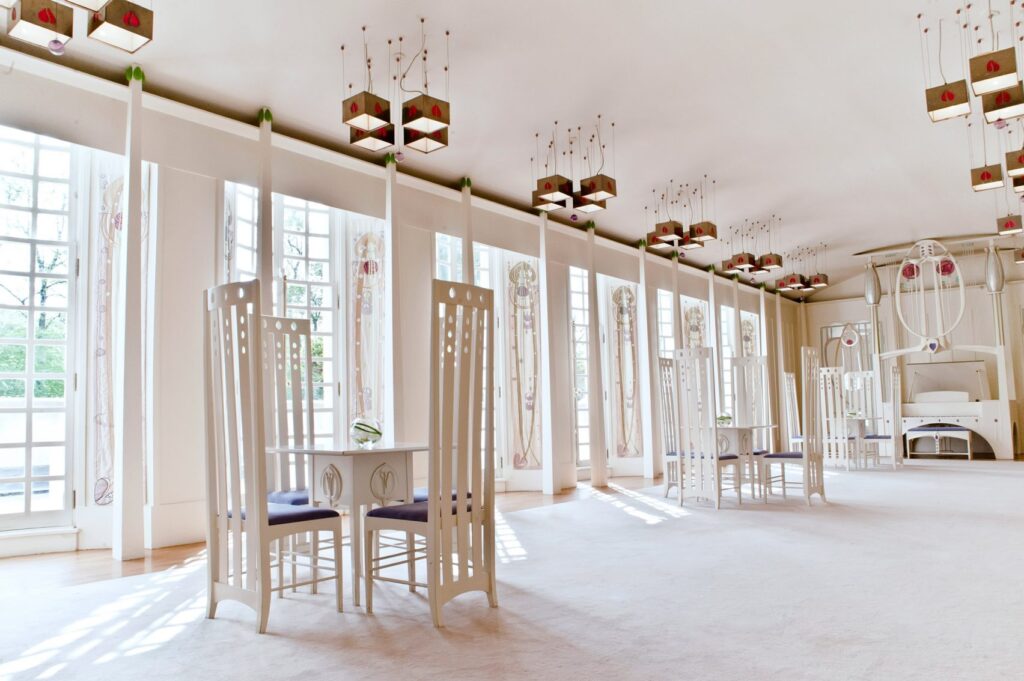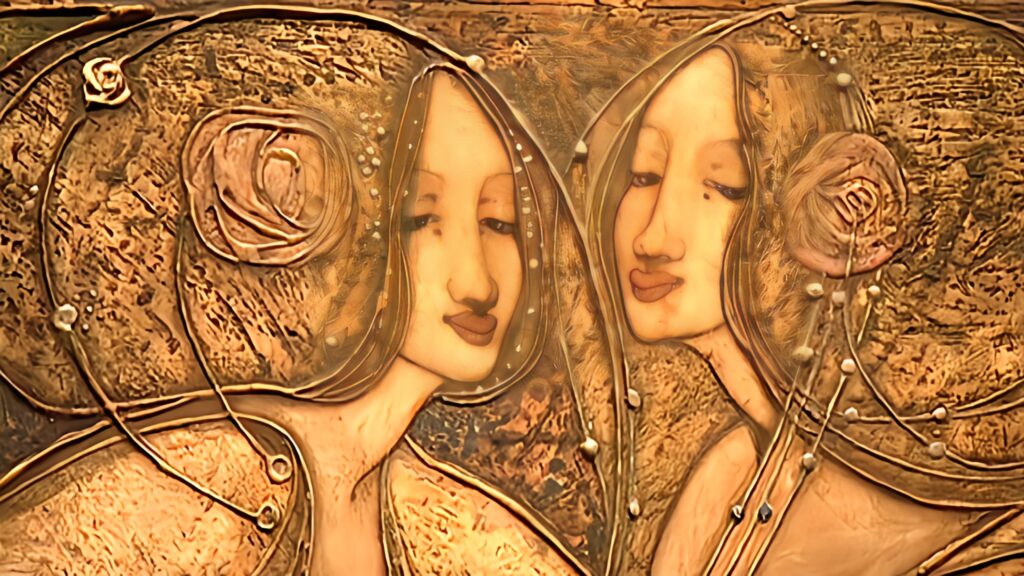Charles Rennie Mackintosh is one such luminant of the world of art and architecture who still shines for us. Famous both here and abroad for his creative blend of artistry with architectural originality. Mackintosh’s influence remains an integral part of Scottish culture. Accompany us on a trip through the life and works of this imaginative master, and trace. His remarkable integration of art with architectural skill that keeps admirers entranced to this day. 🌍✨
The influence of Mackintosh can be seen from his early days in Glasgow to the artistic reproductions, such as The Glasgow School for Art and Hill House. In addition to reengineering architecture, his artistic career amplified the impact of Art Nouveau. Through these, Mackintosh’s life might begin to take on some of the definition that has been missing. We will further understand his death at so young an age and explore a man whose work oversteps boundaries even today. 🏴🌹
Charles Rennie Mackintosh – Early Life and Education:
The story of how Charles Rennie Mackintosh became an artist starts in the city of Glasgow, Scotland. Mackintosh was born in 1868, and creativity came naturally to him. He showed artistic promise when he was young of age. Born in the industrial city It was Mackintosh’s early access to Glasgow’s architectural vitality and cultural environment that shaped his later career. 🏴🌟
But Mackintosh’s educational background also spurred his interest. He studied at the Glasgow School of Art, and was influenced by his teachers there. This academic phase was the beginning of Mackintosh’s unique approach to art and design, ushering in a superb career which would change the world. 🎓🖌️
Charles Rennie Mackintosh- Artistic Influences:
The creative genius of Charles Rennie Mackintosh was closely bound up with his various influences. MacKintosh’s work showed signs of being influenced by the Arts and Craft movement. Japanese art as well as the Symbolist fashion. The blending of these eclectic influences produced an individualistic style that distinguished Mackintosh from the artistic environment in general at that time.
Mackintosh was inspired by the cultural environment of Glasgow, with its thriving industrial economy and Art Nouveau trend. Organic forms and flowing lines are the hallmarks of Art Nouveau, so they naturally became part of Mackintosh’s standard style. This characteristic ability of blending diverse influences into a characteristically individual vision was the earmark. His creative skills, and placed him at forefront in what later became popular as art and design. 🌐🌿
Later, as Mackintosh grew into a mature artist, his European travels only added to the variety of influences. Anything from the pure lines of Japanese design to the ornate detail of European Art Nouveau. All helped form Mackintosh’s sense of his own artistic identity. This tolerance toward the diversification of culture is linked with the special and eternal nature of his works. 🌍🎨
This development was closely intertwined with Mackintosh’s relationship to his wife, Margaret MacDonald. Their succession of works, each rich in symbolism and mutual aesthetic harmony between. The two artists brought MacKintosh’s work to a new plateau. In Mackintosh’s creative career, this sort of collaborative synergy and shared exploration was a living witness to the power within art. 👫🌹
Charles Rennie Mackintosh- Architectural Visionary:
From artist to architectural visionary, Charles Rennie Mackintosh’s transformative path bore witness to his vast imagination. Below are a few examples of Mackintosh’s artistic style applied to architecture. With these as its foundation, this artist chose the profession of architect in his embrace with total confidence. His designs gave life to structures, turning them into works of art that defied the boundaries between function and form.
Mackintosh’s architectural vision was a move away from convention. He was therefore less interested in following current architectural trends than imparting a feeling of artworks into their form through elements that often broke with convention. Mackintosh’s most representative work. The Glasgow School of Art is a shining example of this type where all aspects–from exterior to interior- are an expression of creative architectural artistry. 🎨🏫

Mackintosh soon acquired a reputation for seamlessly integrating artistic principles into architecture. But his designs were not just buildings. They were concrete embodiments of artistic thought. From the Hill House to the Willow Tea Rooms and on through a new generation of adherents, Mackintosh’s architectural spirit is clearly passed along, bearing witness to how one generated thinker revolutionized traditional notions about architecture. 🏡💫
Notable Architectural Works:
The stones of many buildings bear the imprint left by architect Charles Rennie Mackintosh in his great creations. The Glasgow School of Art, one his best-known pieces, is a fine example in which Mackintosh demonstrated how design could inspire creativity. His refusal to accept boundaries was also shown by the asymmetrical, decorative detailing of his building’s intricate facade. Its inside is a symphony of light and space-an end improving on the integrations Mackintosh made between aesthetics and function.
Another masterpiece of Mackintosh’s architecture is the Hill House at Helensburgh. Hill House, designed for publisher Walter Blackie combines simplicity with sophistication. In fact every aspect of Mackintosh’s attention to the natural environment can be seen, from choice of window position and integration with outdoor space. This allows the Hill House to exist not only as a home but also an integrated work complementary with its surroundings. When combined with other works such as the Willow Tea Rooms and the Scotland Street School, these magnificent buildings represent Mackintosh’s lasting contribution to architecture. 🌍🏫
Charles Rennie Mackintosh- Artistic Diversification:
In particular, Charles Renne Mackintosh’s career was a long course of active diversification from the more orthodox architecture. His efforts in interior design, furniture and the decorative arts demonstrated his ability to integrate this aesthetic into every aspect of everyday life. Mackintosh’s artistic hand was not limited to conventional architectural forms, but likewise penetrated the very space of life.
- Interior Design Exploration: Works such as the Willow Tea Rooms also demonstrate Mackintosh’s explorations into interior design. From the furniture to every last detail of decoration, everything carried his personal touch.
- Everyday Aesthetics: Coupled with his sense of spatial aesthetics, these necessities led to a conception of interiors that provided for total experience.
- Microcosm of Art: Hence, this venture into the microcosm of everyday life helped to dramatize Mackintosh’s idea of making art an integral part of daily life. 🏡✨
Margaret MacDonald and Artistic Collaboration:
Charles Rennie Mackintosh’s working relationship with the able designer and artist Margaret MacDonald, whom he married later, was at the heart of his artistic career. This fruitful creative partnership not only enriched Mackintosh’s artistic perspective but also gave rise to some of the most representative works from the Glasgow Style. This was reflected in the attention to detail and symbolic richness of their joint efforts.

One especially successful collaboration was in supplying the famed gesso panels used by Ingram Street Tea Rooms. His panels were decorated with subtle ornamentation, and full of symbolic images that suggest the mutual interest in symbols between husband and wife. MacDonald’s work was not just about decoration though; she and Mackintosh spoke an artistic language between them.
It was out of this same spirit that works like the Wassail and Four Queens were made. Drawing on Mackintosh’s architectural designs and MacDonald’s more symbolical work, these works could be said to represent the art nouveau movement itself. Besides, their dialogue moved beyond the confines of performance art into an expression of artistic creation through love.
Margaret MacDonald was an influential friend of Mackintosh’s, and her art is the key to his work. Through this partnership, they have been able to mutually stimulate each other and it is now part of their legacy. 🌹💑
Charles Rennie Mackintosh- Legacy and Modern Influence:
In the same way that all great creative artists have done, Charles Rennie Mackintosh’s work will be passed down over the ages to future generations. Asking after beauty and efficiency to find the best balance between form and function, his new design has had a lasting impact on art history. It would seem that Mackintosh’s influence is alive and well in many arenas of contemporary life.
Whereas the Glasgow School of Art might be a witness to Mackintosh’s greatness, through relentless scholarly study and re-evaluation it is his spirit that permeates the world. Today, designers and architects are constantly borrowing from Mackintosh’s organic forms, his delicate workmanship or even the way he combines different elements of architecture into one all-embracing entity. In this way his principles for invading daily life with art still hold true today. It seems that he truly was ahead of the curve after all. A model inspirationist Charles Rennie Mackintosh paved the way for the Glasgow style and has always advocated putting art to work, so even today his ideas continue to inspire people who do design work. 🌟🏰
Frequently Asked Questions (FAQs) about Charles Rennie Mackintosh:
1. What exactly is the spirit of Charles Rennie Mackintosh?
Mackintosh employs an eclectic style, combining features of the Art Nouveau and Arts-and-Crafts movements with a Symbolist spirit. The result is careful design that brings together organic sensibility, aesthetic presentation and practical use.
2. What are Mackintosh’s most well-known architectural creations?
Mackintosh’s well-known works include the Glasgow School of Art, Hill House, Willow Tea Rooms and Scotland Street school.
3. What role did Margaret MacDonald play in Mackintosh’s designs?
Mackintosh and his wife, Margaret MacDonald shared their thoughts on working together. MacKintosh’s designs, as in the Ingram Street Tea Rooms panels, benefited from her symbolic artistry and detail.
4. How did Mackintosh influence interior design?
How did Mackintosh’s influence extend into interior space design, as with the Willow Tea Rooms where he packed interiors full of spatial aesthetic and concern for everyday esthetics?
5. What impact has Mackintosh’s legacy had on contemporary design?
His principles of organic form, painstaking detailing and the expression of art in daily life have inspired modern designers throughout the world whereas his vision has remained so fresh.
6. What is Mackintosh’s unique style in architecture?
Architecture with a human face F. spell out Mackintosh’s method of work in architecture, including his use of original designs which challenge the established order and precedents such as The Glasgow School of Art?
7. What kind of cultural movements ran through Mackintosh’s artistic eye?
Mackintosh was inspired by the Arts and Crafts, Japanese art and Symbolist movements. Further travel throughout Europe increased his store of influences.
8. How important is Mackintosh’s collaboration with Margaret MacDonald?
Working with Margaret MacDonald also helped Mackintosh develop his artistic perspective. But it was a union that yielded masterpieces such as ‘The Wassail’ and Four Queens, revealing an exquisite relationship between art and love.
9. What does Mackintosh’s philosophy mean to today’s designers?
Modern designers show their admiration for Mackintosh’s ideas by imitating organic shapes, precise detailing and a unified approach to design.
10. How does Mackintosh employ symbolism in his designs?
Symbolism is an important part of Mackintosh’s designs, especially as expressed in joint projects with Margaret MacDonald. He uses symbolic motifs and imagery to give his works greater depth of meaning.
Know More about Charles Rennie Mackintosh –

